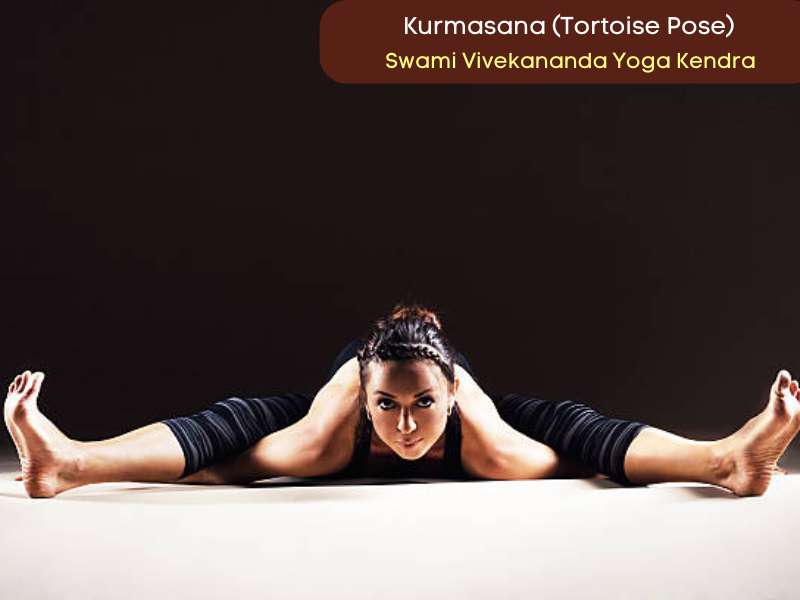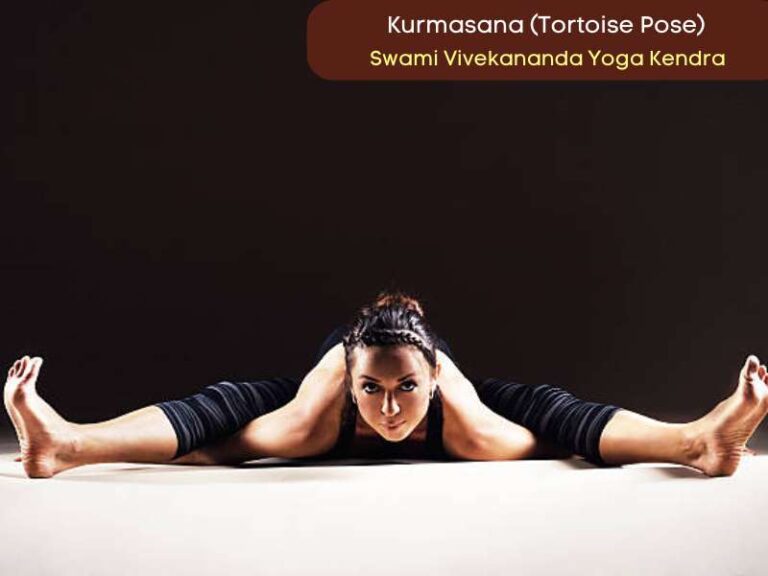Sometimes, the best way to find peace is to simply go inward—just like a tortoise pulling into its shell. That’s the whole essence of Kurmasana, also known as the Tortoise Pose. It’s a calming, forward-folding yoga posture that helps you turn down the noise of the outside world and reconnect with yourself.
In this blog, we’ll walk you through how to do it, why it’s good for your body and mind, and how it can fit beautifully into your yoga journey.
🧘 Step-by-Step: How to Practice Kurmasana (Tortoise Pose)

This pose might look advanced at first glance, but it can be practiced safely by almost anyone—with patience and support. Let’s break it down:
1. Start Seated and Settle In
Sit on your mat with your legs stretched out straight in front of you. Take a few deep breaths to center yourself.
2. Open Your Legs Slightly
Gently spread your legs apart—about the width of a yoga mat or a little wider. You don’t have to force the stretch; just go where your body feels comfortable.
3. Bend Your Knees a Bit
This helps reduce tension in the hamstrings. It also gives your upper body more room to move forward.
4. Slide Your Arms Under Your Legs
Take one arm at a time and gently slide them under your thighs. Your palms should face down. It may feel strange at first—that’s okay!
5. Lower Your Chest Forward
Start to lean your torso forward, as if you’re trying to hug the earth. Your goal is to let your chest sink down between your thighs, not just bend your back.
6. Extend and Relax
Straighten your arms out to the sides under your legs, and if it feels good, begin to straighten your legs a little more. Let your head hang down naturally.
7. Breathe and Hold
Take deep, calming breaths. Stay in the pose for 30 seconds to 1 minute. Focus on how your body feels—no pressure to go too deep.
8. Release Gently
To come out, slowly lift your head, bring your arms back in, and return to a seated position. Move with care.
🌟 Why Practice Kurmasana? (The Benefits Explained)
Kurmasana isn’t just about flexibility. It offers a mix of physical, emotional, and mental benefits that go beyond the mat.
✨ 1. Opens Up the Hips, Back & Legs
This pose gives a wonderful stretch to your hips, hamstrings, and lower back. If you sit a lot or feel stiff, this pose can bring much-needed relief.
✨ 2. Calms the Mind and Reduces Stress
The inward nature of the pose helps quiet the mind. It’s perfect after a hectic day when you just need to slow down and breathe.
✨ 3. Supports Digestion
By gently pressing the belly, Kurmasana helps stimulate the internal organs—especially the digestive system. It can help with bloating and sluggish digestion.
✨ 4. Encourages Turning Inward
Kurmasana is about more than physical flexibility—it’s a meditative pose. It teaches you to look inward and find peace in stillness.
✨ 5. Helps Release Emotional Tension
Many people store stress in their hips and shoulders. This pose gently opens those areas, helping to release tension you didn’t even know you were holding.
✨ 6. Improves Posture and Spinal Health
As you stretch and decompress your spine in this pose, you’re also building awareness of your posture and alignment.
🧠 7. Boosts Mental Clarity
When you fold forward and tune out external distractions, it becomes easier to quiet the mental chatter. This pose creates space for clear thinking, sharper focus, and even creative inspiration.
🧘♀️ 8. Prepares You for Meditation
Kurmasana is a great preparatory pose for meditation. It naturally encourages Pratyahara (withdrawal of senses), helping you shift your awareness inward—ideal before or after a meditation session.
🫁 9. Deepens the Breath
As your torso folds and relaxes, your breathing becomes more conscious and controlled. This deeper, slower breath soothes the nervous system and promotes inner calm.
⚡ 10. Balances Energy (Prana)
In yogic terms, Kurmasana helps balance the Apana Vayu (downward energy flow), supporting grounding and elimination processes. You may feel more stable, centered, and “in your body” after practicing.
💪 11. Strengthens Inner Patience
Unlike flashy poses, Kurmasana teaches stillness and humility. It gently reminds us that transformation doesn’t have to be dramatic—it can be quiet, steady, and internal.
🧍 12. Encourages Body Awareness
As you slowly fold forward, you naturally become more attuned to how each part of your body feels—where you hold tension, where you resist, and where you soften. That awareness is powerful both on and off the mat.
💓 13. Relieves Fatigue and Mental Exhaustion
Feeling mentally drained or emotionally scattered? This pose is like pressing the “reset” button. It promotes a sense of deep rest, even if you only stay in the posture for a minute or two.
😌 14. Helps Manage Anger and Frustration
Folding forward has a cooling, calming effect on the emotions. Kurmasana allows you to slow down, let go, and breathe through emotional intensity.
🦋 15. Opens the Door to Surrender
Some yoga poses are about effort; Kurmasana is about letting go. With time, it teaches you to release control and trust the process—a lesson that carries into everyday life.
🙌 Feeling Curious to Try It?
At Swami Vivekananda Yoga Kendra, we guide students through Kurmasana and other deeply nourishing postures with care, attention, and tradition. Whether you’re just starting out or have years of practice, we’re here to support your journey.
👉 Ready to go deeper? Book a class or drop by our center. We’d love to meet you!
[sc_fs_multi_faq headline-0=”h3″ question-0=”” answer-0=”Absolutely! Flexibility is something we build with time. You can bend your knees, use props like blocks or cushions, and still enjoy the benefits. What matters is the intention, not perfection.” image-0=”” headline-1=”h3″ question-1=”2. My chest doesn’t reach the floor—is that okay?” answer-1=”Totally fine. Your body may never go that far—and that’s okay! Everyone’s anatomy is different. Just focus on relaxing and breathing.” image-1=”” headline-2=”h3″ question-2=”3. Are there any precautions I should know about?” answer-2=”Yes—avoid this pose if you have serious back injuries, hip problems, or are pregnant. When in doubt, ask your yoga teacher before trying it.” image-2=”” headline-3=”h3″ question-3=”4. How often should I practice Kurmasana?” answer-3=”Start with 2–3 times a week. Even a few mindful minutes in this pose can work wonders over time.” image-3=”” headline-4=”h3″ question-4=”5. Can this really help with stress and anxiety?” answer-4=”Yes, and in a big way! The pose activates the parasympathetic nervous system—your body’s natural “rest and digest” mode. You’ll feel more grounded and relaxed after practicing. ” image-4=”” count=”5″ html=”true” css_class=”
Transform Your Life with us: Join Our Online Classes Now:
Ready to dive into a world of wellness? Come join us for some online meditation classes to find your inner calm, hop into our online yoga classes to take your practice up a notch, or why not even become a certified yoga teacher? Embrace the power of yoga today and let it lead you to a happier, healthier you!




Comments are closed.